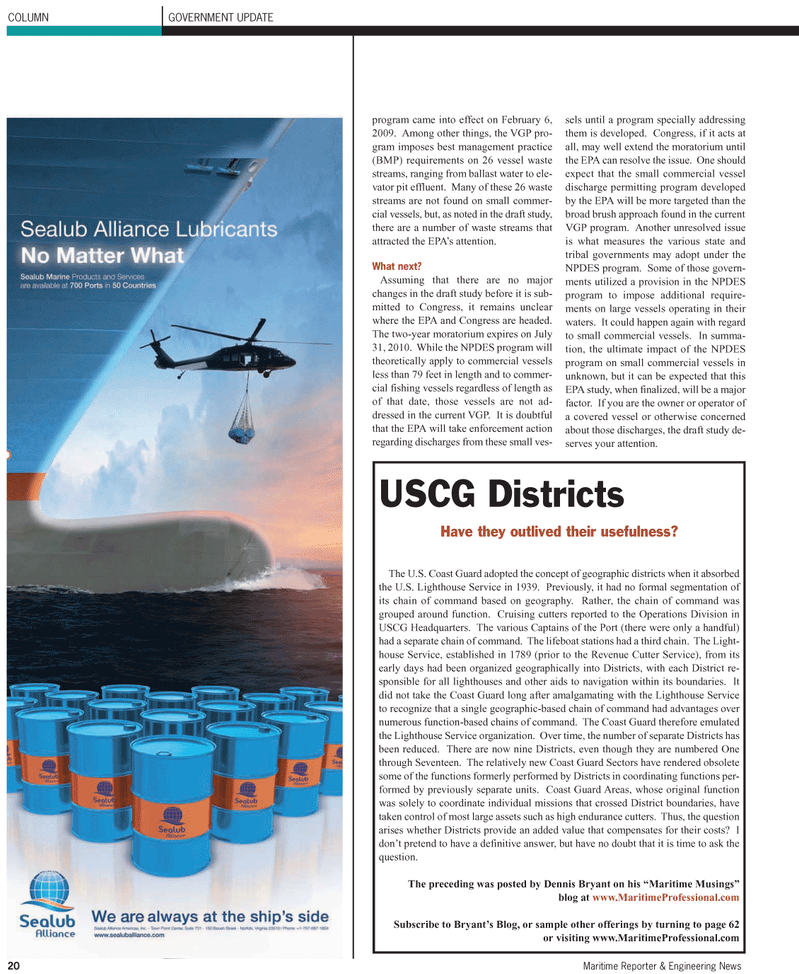
Page 20: of Maritime Reporter Magazine (April 2, 2010)
Read this page in Pdf, Flash or Html5 edition of April 2, 2010 Maritime Reporter Magazine
20 Maritime Reporter & Engineering News program came into effect on February 6, 2009. Among other things, the VGP pro- gram imposes best management practice (BMP) requirements on 26 vessel waste streams, ranging from ballast water to ele- vator pit effluent. Many of these 26 waste streams are not found on small commer- cial vessels, but, as noted in the draft study, there are a number of waste streams that attracted the EPA’s attention.
What next?
Assuming that there are no major changes in the draft study before it is sub- mitted to Congress, it remains unclear where the EPA and Congress are headed.
The two-year moratorium expires on July 31, 2010. While the NPDES program will theoretically apply to commercial vessels less than 79 feet in length and to commer- cial fishing vessels regardless of length as of that date, those vessels are not ad- dressed in the current VGP. It is doubtful that the EPA will take enforcement action regarding discharges from these small ves- sels until a program specially addressing them is developed. Congress, if it acts at all, may well extend the moratorium until the EPA can resolve the issue. One should expect that the small commercial vessel discharge permitting program developed by the EPA will be more targeted than the broad brush approach found in the current
VGP program. Another unresolved issue is what measures the various state and tribal governments may adopt under the
NPDES program. Some of those govern- ments utilized a provision in the NPDES program to impose additional require- ments on large vessels operating in their waters. It could happen again with regard to small commercial vessels. In summa- tion, the ultimate impact of the NPDES program on small commercial vessels in unknown, but it can be expected that this
EPA study, when finalized, will be a major factor. If you are the owner or operator of a covered vessel or otherwise concerned about those discharges, the draft study de- serves your attention.
COLUMN GOVERNMENT UPDATE
USCG Districts
Have they outlived their usefulness?
The U.S. Coast Guard adopted the concept of geographic districts when it absorbed the U.S. Lighthouse Service in 1939. Previously, it had no formal segmentation of its chain of command based on geography. Rather, the chain of command was grouped around function. Cruising cutters reported to the Operations Division in
USCG Headquarters. The various Captains of the Port (there were only a handful) had a separate chain of command. The lifeboat stations had a third chain. The Light- house Service, established in 1789 (prior to the Revenue Cutter Service), from its early days had been organized geographically into Districts, with each District re- sponsible for all lighthouses and other aids to navigation within its boundaries. It did not take the Coast Guard long after amalgamating with the Lighthouse Service to recognize that a single geographic-based chain of command had advantages over numerous function-based chains of command. The Coast Guard therefore emulated the Lighthouse Service organization. Over time, the number of separate Districts has been reduced. There are now nine Districts, even though they are numbered One through Seventeen. The relatively new Coast Guard Sectors have rendered obsolete some of the functions formerly performed by Districts in coordinating functions per- formed by previously separate units. Coast Guard Areas, whose original function was solely to coordinate individual missions that crossed District boundaries, have taken control of most large assets such as high endurance cutters. Thus, the question arises whether Districts provide an added value that compensates for their costs? I don’t pretend to have a definitive answer, but have no doubt that it is time to ask the question.
The preceding was posted by Dennis Bryant on his “Maritime Musings” blog at www.MaritimeProfessional.com
Subscribe to Bryant’s Blog, or sample other offerings by turning to page 62 or visiting www.MaritimeProfessional.com

 19
19

 21
21
